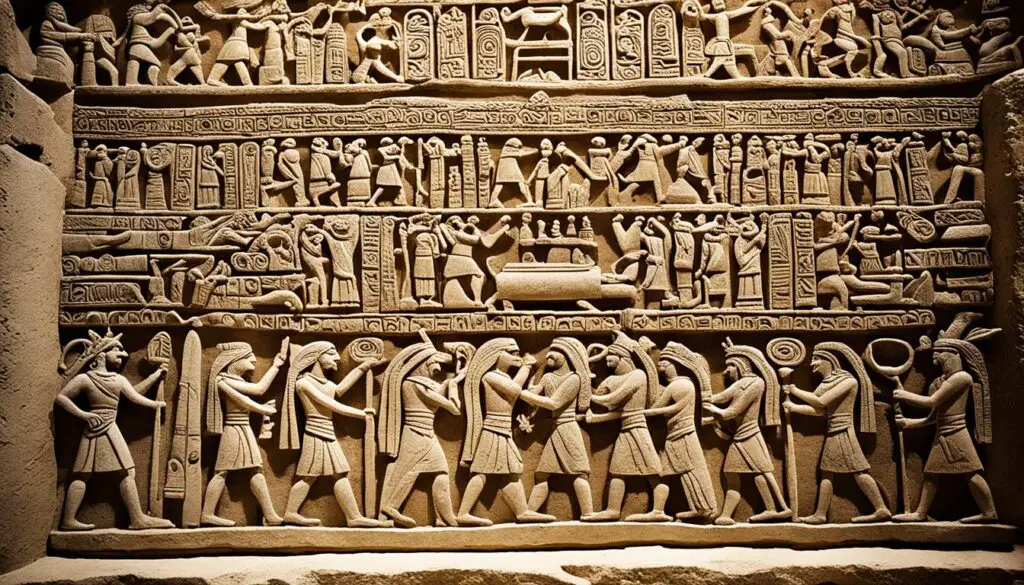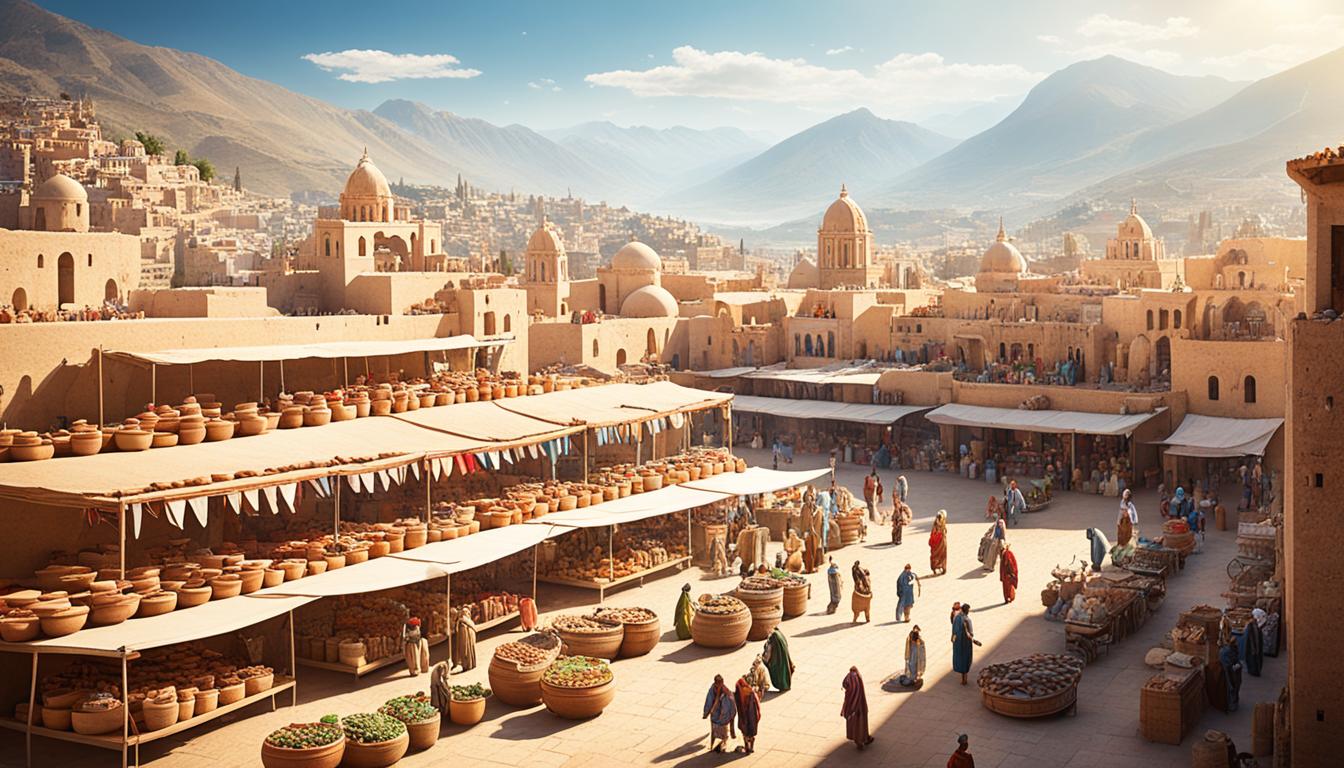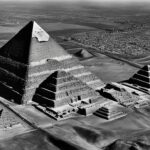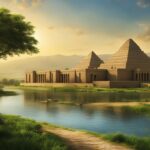Welcome to our comprehensive guide on Canaan, a land steeped in history, culture, and religious significance. In this article, we will explore the ancient Canaanite civilization, its people, culture, language, and archaeology. Stay with us as we uncover the mysteries and wonders of this fascinating land.
Key Takeaways:
- Canaan was home to the Canaanite civilization, centered around Palestine and Syria.
- The term Canaan refers to an area west of the Jordan River.
- The Israelites occupied Canaan, also known as the Promised Land.
- Canaan was influenced by various ancient civilizations including Egyptian, Mycenaean, Cretan, Hurrian, and Mesopotamian.
- Canaanite religion worshipped deities such as El, Baal, Resheph, Kothar, Asherah, and Astarte.
History of Canaan
Canaan, the ancient land filled with captivating stories and vibrant civilizations, carries a rich tapestry of history. The journey through time reveals the footsteps of Paleolithic and Mesolithic communities along the coastal regions, while settled communities emerged at the remarkable site of Jericho as early as 8000 BCE. However, it was during the Neolithic and Chalcolithic periods that widespread settlement in fixed towns and villages flourished, shaping the foundations of Canaanite society.
The introduction of bronze in the Early Bronze Age ushered in a cultural revolution, enabling advancements in metallurgy and craftsmanship. Canaan became a cultural melting pot as Semitic peoples, including the Amorites and Hurrians, made their presence known. It was during the Late Bronze Age that Canaan experienced Egyptian dominance, accompanied by the arrival of marauders known as Hapiru.
Moving forward, the transition from the Late Bronze to the Early Iron Age witnessed a significant event in Canaan’s history: the arrival of the Israelites. Led first by Moses, who parted the waters of the Red Sea, and later by Joshua, the Israelites embarked on a momentous journey to claim their promised land.
Canaanites were renowned for their agricultural practices, cultivating a fertile land that yielded an abundance of crops. Their endeavors transformed the land into a fertile oasis, thriving with wheat, barley, grapes, figs, pomegranates, and olives. This bountiful landscape played a pivotal role in the prosperity of the Canaanite people.
Uncover the captivating tales of Canaan and the remarkable civilization that once called it home. Let’s delve deeper into the captivating world of Canaanite culture, religion, and archaeology in the following sections.
Canaanite Religion and Language
The Canaanites had a fascinating polytheistic religion, with a pantheon of gods and goddesses. At the forefront of their religious beliefs was El, the principal god. They also revered Baal or Hadad, who they believed controlled rainfall and fertility. Other important deities included Resheph, the god of plague and war, Kothar, the god of craftsmanship, Asherah, the mother goddess, and Astarte, the goddess of love and fertility.
Tablet discoveries at the ancient city of Ugarit have provided valuable insights into the Canaanite religion. These tablets contain hymns, prayers, myths, and rituals, shedding light on the religious practices and beliefs of the Canaanites.

The Canaanite language is an archaic form of Hebrew, and the Canaanites were the first people known to have used an alphabet. This early alphabet, known as the Proto-Sinaitic script, was discovered in Late Bronze Age strata at the site of Lachish. It consisted of a combination of Egyptian hieroglyphs and pictographs.
The Canaanites were pioneers in developing a script that would eventually evolve into the Hebrew alphabet, which is still used today. Their contribution to the development of writing systems cannot be overstated.
Key Characteristics of Canaanite Religion and Language:
- The Canaanites practiced a polytheistic religion, with El as the principal god.
- Other important deities included Baal, Resheph, Kothar, Asherah, and Astarte.
- Tablet discoveries at Ugarit have provided valuable insights into Canaanite religious practices and beliefs.
- The Canaanite language is an archaic form of Hebrew.
- The Canaanites were the first people known to have used an alphabet.
- The Proto-Sinaitic script, ancestor to the Hebrew alphabet, was discovered at the site of Lachish.
The Canaanite religion and language are integral to understanding the cultural and historical significance of the Canaanite civilization.
Archaeology of Canaan
Archaeological excavations have provided fascinating insights into the ancient Canaanite civilization, shedding light on their daily lives, practices, and culture. Discoveries at important Canaanite cities, such as Jericho, Jerusalem, and Megiddo, have played a vital role in our understanding of Canaanite history.

These excavations have unearthed a wealth of information, including architectural structures, pottery, and artifacts that provide valuable clues about how the Canaanites lived. For example, the remains of homes, palaces, and temples give us insights into their architectural styles and social structures. The pottery and artifacts, such as jewelry and tools, showcase their craftsmanship and artistic traditions.
These discoveries in Canaan have been instrumental in piecing together the puzzle of the Canaanite civilization, allowing us to glimpse their vibrant and sophisticated society.
One fascinating aspect of Canaanite archaeology is the evidence of cultural exchange and influence from surrounding civilizations. The Canaanites interacted with, and were influenced by, the Egyptians, Mycenaeans, Cretans, Hurrians, and Mesopotamians, resulting in a rich tapestry of cultural elements within their society.
By studying the archaeological findings in Canaan, archaeologists and historians have been able to reconstruct the historical timeline and understand the development and decline of the Canaanite civilization. These insights into Canaanite archaeology continue to shape our understanding of this ancient civilization and its significance in the broader context of ancient history.
Important Canaanite Cities and their Discoveries
| City | Notable Discoveries |
|---|---|
| Jericho | Stone walls, ancient dwellings, tower, and artifacts dating back to the Neolithic period |
| Jerusalem | City walls, temples, palaces, and artifacts from various historical periods |
| Megiddo | Impressive city gates, palaces, stables, and intricate water systems |
The Promised Land in Biblical Narrative
The concept of the Promised Land holds a significant place in the biblical narrative found in the Hebrew text called the Torah. According to this sacred narrative, God made a promise to give the land of Canaan to Abraham and his descendants. This promise was later reaffirmed to Isaac and Jacob, who was then renamed Israel. The Israelites, led by their leaders Moses and Joshua, eventually entered Canaan and claimed it as their inheritance.
“And I will bring you to the land I swore with uplifted hand to give to Abraham, to Isaac and to Jacob. I will give it to you as a possession. I am the LORD.” – Exodus 6:8
However, the possession of the Promised Land was not without its challenges and consequences. Disobedience to God’s law and the worship of other gods led to periods of exile and captivity for the Israelites, including the Babylonian captivity. The biblical narrative of the Promised Land played a crucial role in shaping the identity and beliefs of the Israelite people and later influenced Jewish and Christian traditions.
The Journey to Canaan
The journey of the Israelites to Canaan was marked by various trials and tribulations. After being enslaved in Egypt, they were led by Moses through the wilderness towards the land that had been promised to their ancestors. This journey, known as the Exodus, symbolizes liberation and the fulfillment of God’s covenant with the Israelites.
“I have come down to rescue them from the hand of the Egyptians and to bring them up out of that land into a good and spacious land, a land flowing with milk and honey.” – Exodus 3:8
Once in Canaan, under the leadership of Joshua, the Israelites faced battles and challenges as they conquered the land and established themselves as a nation. The Promised Land became a tangible manifestation of God’s faithfulness to His chosen people.
The Significance of the Promised Land
The Promised Land holds deep significance within the biblical narrative and the Abrahamic faiths. It symbolizes divine blessings, abundance, and a place of rest. The land of Canaan provided the Israelites with a physical homeland where they could worship God and live in accordance with His laws.
Furthermore, the Promised Land represents the fulfillment of God’s promises and His covenant with His people. It serves as a reminder of the importance of faith, obedience, and trust in divine guidance. The biblical narrative of the Promised Land continues to inspire believers today, encouraging them to stay faithful to God’s promises and seek His guidance in their own lives.

The Promised Land: The Israelites fulfilling their journey to the land of Canaan.
Boundaries of the Promised Land
According to the Book of Numbers, the boundaries of the Promised Land encompassed specific geographical features. These borders were defined by God and marked the extent of the land promised to the Israelites.
The southern border of the Promised Land included the Wilderness of Zin and the border of Edom. Moving westward, the coastline of the Mediterranean Sea formed the western border.
The northern border spanned from the Mediterranean Sea to Mount Hor, marking the upper limit of the Promised Land. Finally, the eastern border extended from Hazar Enan to the slopes east of the Sea of Galilee and along the Jordan River.
These biblical borders delineated the sacred territory known as the Promised Land, or Canaan, which held great significance for the Israelites and played a crucial role in their history and religious beliefs.

Unique Features of the Promised Land
The Promised Land, also known as Canaan, possesses unique features that made it a desirable territory for the Israelites. Its description as a land flowing with milk and honey suggests its exceptional fertility and abundance. The fertile soil of Canaan facilitated successful agriculture, allowing for the cultivation of crops such as wheat, barley, grapes, figs, pomegranates, and olives. These agricultural resources provided sustenance and economic prosperity for the inhabitants of Canaan. Furthermore, the presence of mountains in Canaan offered natural protection and security, shielding the land and its people.
Take a moment to visualize the bountiful and prosperous land that awaited the Israelites:

| Crops | Benefits |
|---|---|
| Wheat | Staple food source, used for bread and other food products |
| Barley | Used in the production of beer and bread |
| Grapes | Used for winemaking, a valuable trade commodity |
| Figs | Rich in nutrients, served as a natural sweetener |
| Pomegranates | Symbolized fertility and abundance, used for culinary and medicinal purposes |
| Olives | Produced olive oil, a valuable resource for cooking and religious rituals |
The fertility of the land and the agricultural resources it offered played a vital role in the prosperity and well-being of the Israelites in Canaan.
Fulfillment of God’s Promise
The fulfillment of God’s promise to give the Promised Land to the Israelites happened over several generations. After their deliverance from slavery in Egypt and the subsequent wandering in the desert for 40 years, Joshua led the Israelites into Canaan, where they established themselves as a nation. However, their possession of the Promised Land was contingent on their obedience to God’s commandments. Throughout their history, the Israelites faced challenges, including periods of foreign domination and exile, but they ultimately returned to their ancestral land.
The journey of the Israelites from slavery in Egypt to the Promised Land of Canaan is a testament to the faithfulness of God in fulfilling His promise. As mentioned in the biblical narrative, God made a covenant with Abraham, promising him and his descendants this land as their inheritance. This promise was reaffirmed to Isaac and Jacob, who became the patriarch of the twelve tribes of Israel. After years of struggle and waiting, the Israelites finally entered the Promised Land under Joshua’s leadership.
“Be strong and courageous. Do not be afraid; do not be discouraged, for the Lord your God will be with you wherever you go.” – Joshua 1:9
The possession of Canaan was not without its challenges. The Israelites encountered fortified cities, hostile tribes, and battles that they had to overcome. God guided them through these obstacles when they followed His commandments and remained faithful. However, disobedience to God’s law and the worship of other gods often led to setbacks and consequences for the Israelites.
Despite the difficulties they faced, the Israelites continually returned to their ancestral homeland. They rebuilt their cities, reestablished their worship, and reclaimed the Promised Land as their own. The promise made by God to their forefathers was fulfilled through their perseverance and trust in Him.
The Return from Exile
Throughout their history, the Israelites experienced periods of exile and foreign domination. The Babylonian captivity is one such example, where a significant portion of the population was taken captive to Babylon. However, even in exile, the hope of returning to the Promised Land remained alive in the hearts of the Israelites.
After the Babylonian empire fell to the Persians, King Cyrus issued a decree allowing the Israelites to return to their homeland and rebuild the temple in Jerusalem. This marked a significant turning point in their history, as they once again stepped foot on the land promised to them by God.
The return from exile was a restoration of their identity and a reaffirmation of God’s promise. It was a time of rebuilding, both physically and spiritually, as the Israelites worked to revive their land and their relationship with God.
Continued Presence in the Promised Land
Today, the descendants of the Israelites continue to inhabit the Promised Land, now known as Israel. The fulfillment of God’s promise is evident in the establishment and survival of the nation of Israel. Despite the challenges and conflicts that have arisen over the centuries, the Jewish people have maintained a strong connection to their ancestral land.
The significance of the Promised Land goes beyond the physical boundaries. It represents the faithfulness of God and serves as a reminder of His covenant with His people. The story of the Israelites’ journey to the Promised Land continues to inspire believers around the world and serves as a testament to the enduring nature of God’s promises.
In the next section, we will explore the valuable lessons that can be learned from the Promised Land story and its relevance to our own lives.
Lessons from the Promised Land Story
The story of the Promised Land holds valuable lessons about faith and obedience. The Israelites’ lack of faith and their disobedience had consequences and caused a delay in the fulfillment of God’s promise. Central themes in this narrative include the need for trust in God’s provision, following His guidance, and honoring His commandments.
By examining the story of the Promised Land, we are reminded of the importance of these principles in our own lives. Just as the Israelites faced challenges and temptations, we too encounter obstacles that test our faith and obedience. Yet, through their journey, we see how faith in God’s promises and a commitment to obedience can lead to blessings and fulfillment.
“Trust in the LORD with all your heart and lean not on your own understanding; in all your ways submit to him, and he will make your paths straight.” – Proverbs 3:5-6
When we have faith, we trust that God’s plans for us are perfect, even when we may not understand them. We learn to rely on His guidance and not solely on our own understanding. Obedience becomes an act of reverence and trust, knowing that God’s commandments are designed for our well-being and spiritual growth.
In our journey through life, the story of the Promised Land serves as a poignant reminder that faith and obedience go hand in hand. Through faith, we find the strength to overcome challenges, and through obedience, we align ourselves with God’s will and experience His blessings.
As we reflect on the lessons from the Promised Land story, let us strive to deepen our faith, strengthen our obedience, and trust in God’s promises for our lives.
| Lessons from the Promised Land Story | Key Takeaways |
|---|---|
| 1. Faith | Trust in God’s provision and plans |
| 2. Obedience | Follow God’s guidance and honor His commandments |
| 3. Challenges | Face obstacles with faith and obedience |
| 4. Blessings | Experience God’s fulfillment and blessings through faith and obedience |
Conclusion
The ancient Canaanite civilization and the concept of the Promised Land have had a profound impact on both ancient civilizations and religious traditions. Canaan, with its rich history and diverse culture, played a crucial role in the development of the Israelites and their understanding of God’s promises. Through the biblical narrative, the Promised Land became a symbol of hope and a testament to the faith and obedience required of believers.
Today, the land of Canaan, now known as Israel, continues to be a focal point of religious, historical, and archaeological studies. The biblical narrative surrounding the Promised Land is still revered and studied, shaping the beliefs and identities of individuals and communities.
The story of Canaan and the Promised Land serves as a reminder of the importance of faith, trust, and obedience in our own lives. It teaches us to rely on God’s provision, follow His guidance, and honor His commandments. The legacy of Canaan and the Promised Land lives on, influencing both ancient history and modern perspectives.







